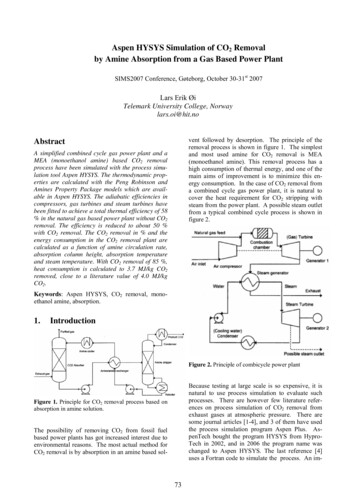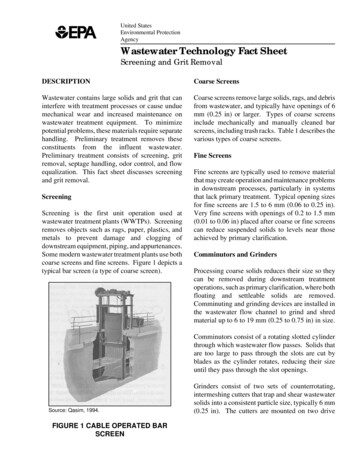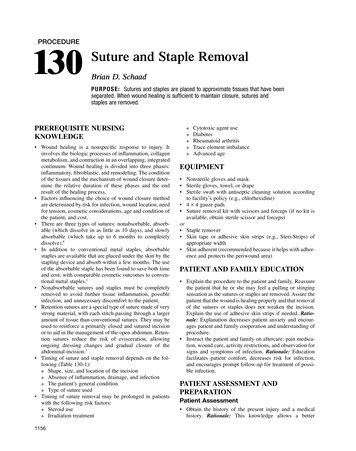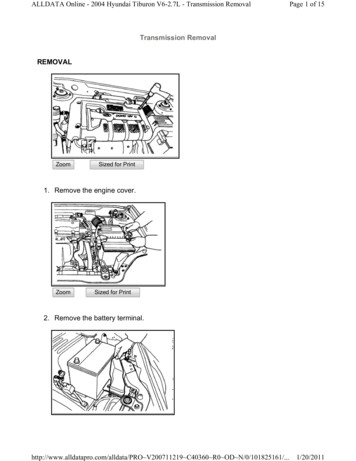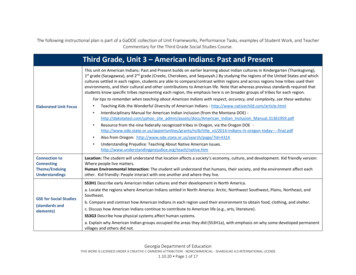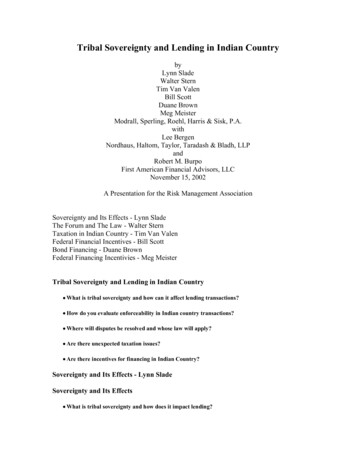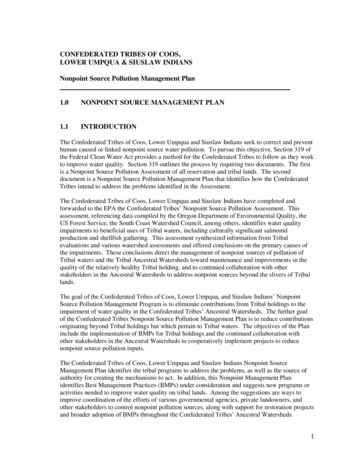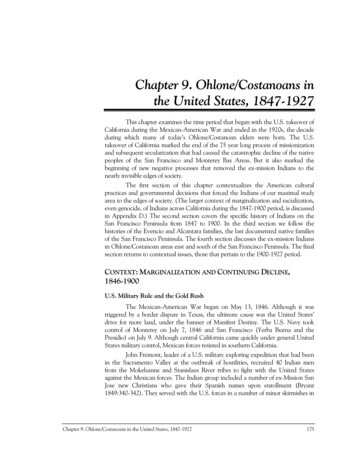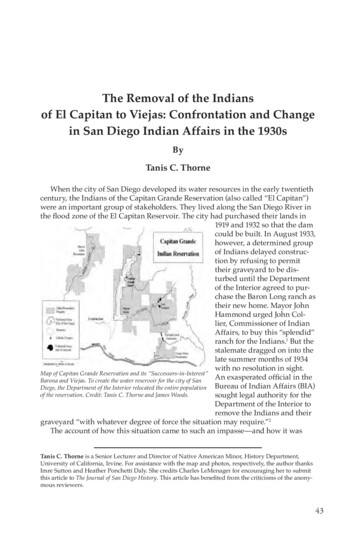
Transcription
The Removal of the Indiansof El Capitan to Viejas: Confrontation and Changein San Diego Indian Affairs in the 1930sByTanis C. ThorneWhen the city of San Diego developed its water resources in the early twentiethcentury, the Indians of the Capitan Grande Reservation (also called “El Capitan”)were an important group of stakeholders. They lived along the San Diego River inthe flood zone of the El Capitan Reservoir. The city had purchased their lands in1919 and 1932 so that the damcould be built. In August 1933,however, a determined groupof Indians delayed construction by refusing to permittheir graveyard to be disturbed until the Departmentof the Interior agreed to purchase the Baron Long ranch astheir new home. Mayor JohnHammond urged John Collier, Commissioner of IndianAffairs, to buy this “splendid”ranch for the Indians.1 But thestalemate dragged on into thelate summer months of 1934with no resolution in sight.Map of Capitan Grande Reservation and its “Successors-in-Interest”Anexasperated official in theBarona and Viejas. To create the water reservoir for the city of SanDiego, the Department of the Interior relocated the entire population Bureau of Indian Affairs (BIA)of the reservation. Credit: Tanis C. Thorne and James Woods.sought legal authority for theDepartment of the Interior toremove the Indians and theirgraveyard “with whatever degree of force the situation may require.”2The account of how this situation came to such an impasse—and how it wasTanis C. Thorne is a Senior Lecturer and Director of Native American Minor, History Department,University of California, Irvine. For assistance with the map and photos, respectively, the author thanksImre Sutton and Heather Ponchetti Daly. She credits Charles LeMenager for encouraging her to submitthis article to The Journal of San Diego History. This article has benefited from the criticisms of the anonymous reviewers.43
The Journal of San Diego Historyultimately resolved—remains an important, but little known, story. This essay willexamine the controversy over the purchase of the Baron Long Ranch, now knownas ‘Viejas.’ San Diego Indians demonstrated historical agency as they defendedtheir vested rights to resources. The resistance of this small group of CapitanGrande Indians in the early 1930s is arguably a defining moment with long-termconsequences for San Diego County’s political and economic landscape. Further,the controversy over the Baron Long ranch purchase provides a window into SanDiego’s role in the complex issues convulsing local and national Indian politics inthe 1920s and 1930s.BackgroundWresting control of the water resources of the San Diego River—critical to thegrowth and prosperity of San Diego—was complicated. The city of San Diego hadto contend with the vested water rights of the Cuyamaca Flume Company andlocal water districts.3 It also had to get consent from the Department of the Interiorto use federal trust land since the Capitan Grande reservation was under its protection. The federal agency within Interior—the Office of Indian Affairs (or OIA, laterrenamed the Bureau of Indian Affairs or BIA)—served as guardian and land manager for Indian wards. Relinquishing federal trust land in this manner could seta precedent so the arrangement was carefully reviewed. Initially, federal officialsopposed the dam project but, by 1916, they became convinced that the interestsof two hundred Capitan Grande Indians should give way to the fast growingpopulation of San Diego.4 In1919, following enthusiastictestimony by Commissionerof Indian Affairs Cato Sells,Congress passed the El Capitan Act (40 Stat 1206). Thislegislation transferred waterrights and valuable acreage inthe granite-walled San DiegoRiver canyon to the city of SanDiego.The El Capitan Act specified that the Capitan GrandeIndians would be relocatedas a group and village lifereconstituted.5 The IndianOffice believed it was fulfilling its duty as guardian bybartering for an improvedstandard of living for thedispossessed. The city agreedto pay for removal and fullrehabilitation of the CapitanGrande Indians, at a cost ofVentura Paipa, leader and spokesperson, ca. 1905. Courtesy of theCalifornia History Room, California State Library, Sacramento. 361,420. It also recognized44
The Removal of the Indians of El Capitan to ViejasEl Capitan Dam site on the San Diego River, December 16, 1917. SDHC OP #12423-857.that the consent of the Indians was needed for the surrender of these valuableresources. Commissioner Cato Sells repeatedly visited Capitan Grande to persuadethe Indians that moving was in their best interests. Families under the leadershipof Ramon Ames lived in the flood zone and held valuable water rights of fortyminer’s inches to the San Diego River. They finally agreed. In return for their cooperation, Sells promised the Indians they could choose a property nearby for a newhome.While this resolution seemed to satisfy the BIA—and benefit both the city andthe Indians—it masked two problems. First, a small faction of people living in thesouthernmost part of the flood zone under Ventura Paipa’s leadership steadilyprotested the land transfer from the late 1910s to the early 1930s. Second, there wasanother village within the reservation—the Conejos village along the San DiegoRiver’s South Fork/Conejos Creek. The Department of the Interior did not solicit,nor obtain, the consent of this community to removal because the isolated villageof Conejos was outside the dam’s flood zone. Later, city engineers decided that theConejos people should also leave the reservation in order to ensure the purity ofthe city’s water source. Cattle, however, remained.In 1932, the federal government promised the city it would gain the Conejospeople’s voluntary consent to relocate; this was intended to secure the commitmentof San Diegans to the El Capitan site.6 Construction of the dam had been held upfor more than a decade by litigation brought by Ed Fletcher, the Cuyamaca FlumeCompany, and San Diego’s water districts. Since more money was needed to buyadditional Capitan Grande acreage, cash-strapped San Diego taxpayers had begunto consider other reservoir sites in the 1920s and early 1930s. The 1932 amendment to the 1919 El Capitan Act approved of the transfer of additional reservationacreage; significantly, it also provided the Department of the Interior with discre-45
The Journal of San Diego HistoryJames (Santiago) Banegas and his family at their home on the Capitan Reservation, ca. 1917. SDHC OP #15362-386.tionary authority to distribute the city’s funds in order to rehabilitate all of theCapitan Grande people, not just those living in the flood zone whose move wascompulsory.7The ambiguities of 1916 to 1934 were fertile ground for intra-reservation factional divisions. The Ramon Ames group was surprised to learn that the SanDiego relocation fund would have to be divided with the Los Conejos people. Theywere also dismayed when the BIA opposed the purchase of the property they hadselected as their new home: the Barona Ranch northwest of Capitan Grande. JohnCollier of the American Indian Defense Association (AIDA) pressured the BIA tohonor its promise. Fifty-seven people in the Ames group moved to Barona in 1932.The Paipa and La Chappa families adamantly refused to go to Barona; these thirteen individuals (later fourteen) forged an alliance with the Conejos community,demanding the purchase of Baron Long property in the Viejas Valley south of theConejos village.National and State PoliticsThe Capitan Grande Indian removals of the 1930s should be viewed on a largergeopolitical canvas that includes local, state, and national politics. The politicalstruggle over the Baron Long Ranch was linked to the rise of the Mission IndianFederation and California Indian political activism over the California Claims case;the intense debate over the innovative California plan (aka the Swing-Johnson bill);Commissioner Henry Scattergood’s “scattering plan”; and finally the Depressionera crisis in federal Indian policies.For California Indians, a powerful force had been unleashed in the 1920s like abear awakened from hibernation. They were angered at the many acts of dispossession and abuse that had taken place since the mission era. John Collier observedthat numerous acts of past theft, enslavement, and maltreatment were “present intheir memories, emotions and continuing attitudes of mind.”8 Herman “Fermin”46
The Removal of the Indians of El Capitan to ViejasOsuna retained the bitter memory of being egregiously robbed eighty years earlierwhen the Treaty of Santa Ysabel failed to be ratified by the U.S. Senate. When askedif he had any statement for a Senate investigating committee in July 1934, Osunareplied: “I want my home back When the treaty was made my grandfather wasgiven that place and they have chased me away from there.”9 Hope had also beenawakened. For California Indians, there was now the possibility of justice andcompensation in the future with the California Claims case.The Mission Indian Federation, founded in 1919, was a grass-roots organization that used small donations from Indian people to lobby for compensation forSouthern California Indians for their historic land and resource losses. In 1928,after years of agitation by Indians, the California Jurisdictional Act passed, allowing the state of California to sue the federal government on behalf of the Indians ofCalifornia to recover damages. Indian occupancy rights had not been extinguishedbecause the Senate failed to ratify the 1851-1852 treaties. California Indiansdemanded compensation for lands lost in the California Claims case. The federalIndian Office was the main political target, accused of holding Southern CaliforniaMission Agency Indians subordinate to its will as wards. “The Indian Bureau is apetrified, crystallized machine, indifferent to criticism, hostile to reforms, ambitious for authority, demanding increased appropriations and a rapidly expandingpersonnel,” charged Purl Willis, the Federation’s white counselor.10 The Federationwanted to abolish the BIA and to return to “home rule.” Winslow J. Couro, spokesman for the Santa Ysabel Band of Mission Indians, summarized the position of theCapitan Grande School children around 1905. Courtesy of the California History Room, California StateLibrary, Sacramento, California.47
The Journal of San Diego HistoryFederation members: “We only want a little of what we have left and then leave usalone. We don’t need superintendents, farmers, subagents, social workers, education executives and dozens of other employees.”11Southern California Indians and non-Indian reformers found common groundin the late 1920s and early 1930s. Critics assailed the federal Indian Office whilethe AIDA and other newly formed organizations demanded radical reform inthe administration of Indian affairs. Momentum began building for settling theCalifornia Claims case and for the passage of the Swing-Johnson bill that wouldtransfer criminal jurisdiction and administration of social services for Indiansfrom the discredited BIA to county and state authorities—along with the federalfunds to pay for these programs. In 1932, the Mission Indian Federation leadershipinvited John Collier, a prominent AIDA official, to speak at a meeting of the SanDiego Chamber of Commerce. Collier sought the Federation’s endorsement as thenew Commissioner of Indian Affairs and spoke approvingly of the Swing-Johnson“home rule” bill.12 In his Annual Report in 1931, Commissioner of Indian AffairsCharles Rhoads applauded the “California Plan”—“an experimental method fordecentralizing Indian affairs”—for its potential to gradually liberate Indians fromgovernment wardship.13Gauging the political winds, Commissioner Rhoads and his assistant HenryScattergood saw the evacuation of Capitan Grande as an opportunity to implementthe long-range goal of ending federal responsibility, beginning with Southern California’s Indian population. Rhoads asserted Southern California’s Mission Indianswere “only slightly different from Mexican-American citizens in same communities” and “amalgamation into local communities is possible.”14 Scattergoodembraced a plan introduced by San Diego Congressman Phil Swing for “scattering” at least some of the Capitan Grande Indians. Many San Diegans disliked theidea of having new federal trust reservations created in San Diego County becausetrust status meant exemption from county tax rolls and thus a heavier tax burdenBarona Ranch, April 1899, owned by J.E. Wadham. SDHC #358.48
The Removal of the Indians of El Capitan to ViejasBaron Long Ranch, ca. 1930, was a level, fertile field on the floor of the Viejas Valley. When this photo was taken,erosion was negligible. SDHC #5271.on non-Indians.15 The so-called “Scattergood suggestion” was dispersal: “endingof tribal life and location [of Indians] on individual plots of land near populationcenters.”16The Battle for Baron Long Ranch (or Viejas)A stalemate developed in 1931-1932. Whereas the BIA promoted the scatteringoption and persisted in offering dozens of alternative properties for relocationin San Diego County to those Indians who did not move to Barona, a consensussteadily built among the Paipa/La Chappa coalition and the Conejos communityfor the purchase of Baron Long’s ranch.Why did the BIA steadfastly refuse to buy the Baron Long ranch? A big stumbling block was the price: Baron Long asked 200,000 (later lowered to 125,000)for the 1,609-acre ranch. The Barona ranch cost 75,000 and had nearly four timesthe acreage. The large sum of money provided by San Diego— 361,420, plus payment for the additional 920 acres in 1932—suddenly seemed too small. To pay suchan exorbitant price for the ranch would leave insufficient money for homes withindoor plumbing, irrigation systems, and other improvements to rehabilitate theremaining Indians to be removed from Capitan Grande. If the standard of livingfor the Conejos-Paipa group was not raised to a commensurable level to the Baronas, the moral justification for the federal guardian agreeing to relocate them wasundermined.There were, moreover, serious concerns among federal officials about whetherthe eroded Baron Long ranch had adequate water and agricultural land to promiseself-sufficiency for the Indian population in the long term. Without the potentialfor prosperity, the termination of federal guardianship was illusory. The federalgovernment clearly did not want to burden taxpayers with the costs of renovat-49
The Journal of San Diego Historying the Baron Long ranch, nor place Indians where they would be condemned topoverty and dependency.There was a political as well as an economic dimension of the problem. Much ofthe opposition to the purchase of Baron Long can be traced to the ongoing politicalstruggle between the BIA and the Mission Indian Federation and, more specifically, between the BIA and Purl Willis, the Federation’s white counselor. BaronLong’s ranch was not the Indians’ choice, many believed, but rather Purl Willis’schoice. There were well-founded suspicions that Willis stood to gain personallyby getting an estimated 7,500 commission from the seller, Baron Long. Allegedly, Willis was manipulating the Indians for his own political and personal gain.Willis’s many enemies did not want to be railroaded into buying a substandard,overpriced property by a racketeering minority under Willis’s command.17At the time, most BIA personnel and reformers assumed that the Paipa groupand the Conejos people were mere pawns in Willis’s schemes. Their assumptionwas both ethnocentric and simplistic. The relationship among Willis, the Federation’s Indian leadership, and the rank-and-file membership was dynamic andsymbiotic. Much as Ramon Ames turned to the pressure group (the AIDA) for helpto secure the Barona property when the Interior Department dragged its feet, thePaipa group needed the political clout of the Federation to support its bid for theBaron Long Ranch. All Mission Indians wanted to have compensation for landssurrendered in the 1852 Treaties of Temecula and Santa Ysabel, a cause that theFederation was fighting. Living on the razor’s edge of survival with minimal waterrights and little arable land, many southern California Indians depended upon theFederation as a counterweight to the heavily paternalistic BIA and its unpopularand unworkable programs. Southern California’s Mission Indian Agency Indiansmoved in and out of Federation membership depending on whether or not theythought that the Federation was serving their goals.Ventura Paipa, a Capitan Grande Indian, was an advocate for purchase of theBaron Long property. Born around 1879, he was the seventh child and fourth sonin a large family. Since his family lived at Capitan Grande for upwards (perhapsconsiderably upwards) of eighty years, many of those buried at the graveyard inthe southern end of the San Diego River canyon were his relatives. He strenuouslyand continuously opposed the disturbance of these graves. Paipa and his brothersalso had homes and other structures, fences, stock, and crops in the flood zone.18His personal experience with federal autocracy, betrayal, and hypocrisy crystallized into an ingrained cynicism of government motives and skepticism regardinggovernment promises. A spokesperson and leader (and very much his own man),Paipa was a vocal opponent of the dam project from the idea’s inception in the1910s. In the 1930s he pursued a policy of non-cooperation and became a majoradvocate for the purchase of the Baron Long ranch.Politically, the Paipa and La Chappa families were stalwart Federation members. Juan Diego La Chappa, a Federation Captain, took a lead in enforcingFederation policy in 1925 when he charged a couple with adultery at Sycuan.19 TheLa Chappas and Paipas had relatives in the Los Conejos village. Ventura Paipa’skinsman, Captain Felix Paipa of the Conejos band, was an important ally duringthe relocation struggle.20The field notes of linguist John P. Harrington provide some suggestive evidencethat cultural factors were in play in the political alignments at Capitan Grande.50
The Removal of the Indians of El Capitan to ViejasHarrington’s notes indicate that thePaipas and La Chappas of Los Conejos were the best Indian speakersof the Tipaay (Southern Diegueño,or, Kumeyaay) dialect. All the Paipafamily’s “witch stuff” had beeninherited by Sylvester Paipa, olderbrother of Felix. When Sylvesterdied, Felix acquired a sacred object,the teaxor rock. As Felix did notwant it, he passed it to VenturaPaipa who ritually manipulatedit. These and other details in Harrington’s field notes indicate the LaChappas and Paipas were culturallyconservative. For them, authorityderived from both political skill andthe ownership of sacred objects andesoteric ceremonial knowledge.21The Paipa and Conejos groupsremained unified on the relocation issue due to a combination offactors, including kinship ties, language, shared worldview, and theFederation’s political organizationalwork. They also remained togetherAmbrosio Curo and Manuel Banegas walking up a canyonbecause they were attracted to,at Capitan Grande to find the site of an eagle’s nest, Augustand familiar with, the Baron Long1917. SDHC OP #15362-858.Ranch. A warm wintering zone andlocale for seasonal work, the Viejas Valley was rich in memories for the Conejospeople. Baron Long, a flamboyant and wealthy man, owned many properties inSouthern California, including the Agua Caliente race track, the U.S. Grant Hotelin San Diego, and the 1,609-acre horse ranch in the Viejas Valley, described as a“showplace.” Baron Long pastured his racehorses here. It had a sportsman’s outof-town clubhouse, an abundance of hay and alfalfa, and ten to twelve barns. ThePaipa brothers, stock-raisers and horse-lovers, were attracted to the Baron Longproperty, particularly as one of their major financial assets was a large horse herd.Presumably, the Paipa family’s livelihood involved providing transportation toIndians and Mexicans traveling for social events (inter-tribal fiestas) and seasonaloff-reservation work on non-Indian farms and ranches.Baron Long’s Ranch was, in many respects, the ideal place for relocatingthe remaining Capitan Grande people. Congress validated the Capitan Grandepeople’s continued ownership of all the reservation lands not transferred to thecity of San Diego for the dam: 14,473 acres.22 If the federal government purchasedan additional strip of land between the ranch and the existing reservation, a landbridge would connect the two and provide Conejos stock raisers with access to anextensive grazing annex at their old home, as well as access to Capitan Grande’sother cultural and material resources.2351
The Journal of San Diego HistoryEl Capitan Dam under construction, June 25, 1932. SDHC #4334-A-15.Purl Willis: The Man, The MotivesPurl Willis may or may not have manipulated the Capitan Grande people, buthe certainly played a prominent role as in the Baron Long affair. In some circles,he was known as a friend to the Mission Indians, while in others he had a reputation as a scoundrel.24 These two views cannot be reconciled. What is indisputable isthat he was an ambitious man who sought to position himself as the power brokerbetween Southern California Indians and the federal government in the 1930s.A key to understanding Willis’s character and ideology was the fact that hisfather was a Baptist minister while his older brother, Frank, was a prominent,successful, and ambitious Republican politician. Frank Willis served as a U.S.representative (1911-1915), as governor of Ohio (1915-1917), and as a U.S. senator(1921-1928). He died in 1928 while campaigning against Hoover for his party’snomination for the presidency.25Purl Willis was a person of undoubted ability who had important politicalconnections in Washington, D.C. He was also remarkably tenacious, makingappearances at no less than 134 Congressional hearings on Indians from 1931 to1957. Willis, like his northern counterpart Frederick Collett (white counselor of theIndian Board of Cooperation) inspired intense loyalty among many Indians. Willis’s enemies described him as a crook and a parasite who created divisions in theSouthern California Indian population with his self-serving agitation.26Unquestionably, the Federation was a very divisive political organization,politicizing Indian communities in southern California and pitting Federation52
The Removal of the Indians of El Capitan to Viejasand anti-Federation factions against one another. Like a colonized people fightingoff a foreign power, the Federation used litigation and political violence to protestthe BIA’s authority over them. In essence, two rival governments vied for powerand legitimacy in Southern California: the BIA and the Mission Indian Federation.There was much bad blood between the BIA and the Federation, and they wereevenly matched.27Elected as deputy county treasurer of San Diego County in 1931, Willis foundpolitical opportunity in the bleakness and chaos of Depression-era Southern California.28 He built his career as an Indian expert and liaison after he was appointedby the San Diego Board of Supervisors as one of three members of a commissionstudying conditions of Indians on San Diego reservations. Unlike others whoclaimed that the poor conditions were sensationally overblown, Willis was highlycritical of the BIA. A lifelong Republican, Willis supported the transfer of BIAauthority to state and counties agencies, first endorsing the Swing-Johnson bill(enacted into law as the Johnson-O’Malley Act) and later House Resolution 108 (thetermination policy of the post-World War II era) and Public Law 280.Confrontational Politics, 1932-1933The BIA and the City of San Diego sought, first, to move the Paipa group andtheir graveyard from the flood zone, preferably without the use of force; and,second, to persuade the Conejos group to move away from Capitan Grande voluntarily, preferably as individual family groups severing their tribal ties. Federalbureaucrats, enmeshed in the social-engineering mentality of the age, assumedthat the superior planning by intelligent, professional experts would neutralizethe Federation’s influence. “Whether [the Paipa group] will move before it becomesEl Capitan Dam, June 1955. SDHC #81:12430.53
The Journal of San Diego Historynecessary to move them by force,” wrote a Brookings Institute analyst “is a test ofgovernment ingenuity and intelligence.”29At Capitan Grande, a reservation roll was being finalized to ascertain thenumber of shareholders and the exact amount of each person’s per capita share.The special agents that Scattergood had set to the task of persuading the Indians toscatter were optimistic. Once the exact value of each share was decided, some whowere vacillating might be induced to purchase individual properties close to urbanareas and employment. Special Agent Mary McGair was engaged in assessingpreferences in July 1932.30Ventura Paipa and the Mission Indian Federation should be credited for anamazing political feat at this juncture: upending the BIA’s well-laid plans andturning the situation at Capitan Grande to their own advantage. Rather thanbeing outsmarted or overpowered, the tiny Paipa-La Chappa group stood united.At a meeting at Conejos on December 29, 1932, a vote was taken of enrollees whowanted per capita shares of the Barona property. All were opposed.31 Two monthslater, in February 1933, those in Conejos joined in the petition with the Paipa groupto purchase the Baron Long ranch, touting its advantages of nearly 900 acres ofalmost level farm land, farm machinery in good condition, barns and stables forhouses and stock, electricity, and other modern conveniences. Adam Castillo laterconfessed that the captains, or village leaders, appended many of the signators’names to the petition. With reason, the BIA clearly suspected that Willis, Federation President Adam Castillo, and the Federation Captains were misrepresentingthe will of a few as that of the community as a whole.32In order to break the hold of the Federation, an important meeting was held atLos Conejos on March 5, 1933, with Castillo and thirty other Indians in attendance.Agent McGair declared that each person would get 2,474.80 for land, a new house,furniture, livestock, and other necessities, plus a share of the general reserve fund.When Castillo, instead, urged the purchase of the Baron Long ranch as a group,McGair downplayed this possibility. She cautioned that an engineer would haveto study the property for its suitability. In addition, an official petition wouldneed to be signed by all who wanted the property and all names on the petitioncross-checked with the roll. Willis wanted the Baron Long property checked outimmediately by his own engineer, implying the BIA engineers were biased. Anotarized petition, formally requesting the purchase of Baron Long ranch, datedMarch 20, 1933, included the names of Adam Castillo and Vincente Albanez (twoFederation leaders not enrolled at Capitan Grande), along with Felix Paipa for LosConejos, Juan Diego La Chappa and Ventura Paipa for “El Capitan.”33Despite this demonstration of unity, the BIA and Indian Rights activists dugin their heels to oppose the purchase of the Baron Long ranch. They thought thatits purchase would represent a political victory for the Federation, enhancingWillis’s reputation with Indians and further eroding the fragile authority of theBIA in southern California. Nickel-and-dime contributions by California Indianswere pushing the California Claims bill through Congress. Together, Willis andCollett—the white counselors to the southern and northern grassroots Indianorganizations—raised money to go to Washington, D.C., to lobby for the CaliforniaIndians’ right to hire their own legal counsel. Opponents viewed both Collett andWillis as racketeers out to enrich themselves, men who were ominously positioning themselves as middlemen in the California Claims case settlement that54
The Removal of the Indians of El Capitan to ViejasSchoolhouse at Capitan Grande, ca. 1900-10. Courtesy of the California History Room, California State Library,Sacramento, California.potentially involved millions of dollars. One federal employee publicly accusedWillis of collecting 88,000 from the Mission Indians to enrich himself. The BaronLong’s ranch purchase was now a strategic asset in a larger struggle in which thestakes were large.34In 1933, California Indians became better organized than ever before. At thesame time, the BIA was extremely vulnerable, thus providing an opportunity fora minority to exercise unaccustomed power. The Old Guard BIA was in disgrace.The Federation’s membership was cresting to over half of the adults in the MissionIndian Agency. A Senate sub-committee was crisscrossing the nation, making several stops in Southern California, and lending a sympathetic ear to testimony fromIndians about how and why the BIA had failed them. On its September 1932 tour,the Senators found disgraceful conditions on San Diego County’s Indian reservations. Different bills before Congress to settle the California Claims suit buoyedhopes of justice and financial compensation. President Franklin Delano Roosevelt’s newly appointed Commissioner of Indian Affairs, John Collier, recognizedthe Federation as an organization legitimately representing Southern CaliforniaIndians.35 The Swing-Johnson bill was still viable. Congressman Swing interviewedPresident Adam Castillo about the Federation’s goals in late 1932. The latter toldhim that the California Indians wanted per capita cash payouts in the settlement. Since Swing believed that Indians could not be trusted with this money, hedecided that Willis or others should handle the money according to the outlines ofthe Swing-Johnson bill.36Increasingly perceived as a self-interested outside agitator
Congress passed the El Capi-tan act (40 stat 1206). this legislation transferred water rights and valuable acreage in the granite-walled san diego river canyon to the city of san diego. the El Capitan act speci-fied that the Capitan grande Indians would be relocated as a group and village life reconstituted.5e Indian th


